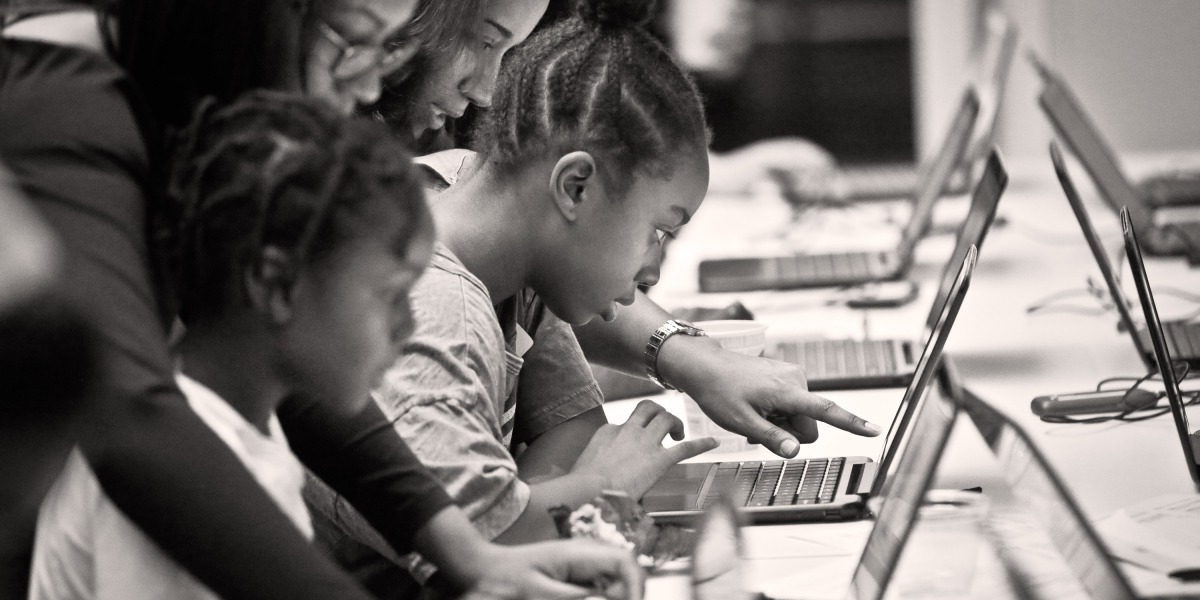Learning to code isn’t enough

The very existence of these training endeavors reflected a mixed set of motivations on the part of the organizers, who were mostly white, well-off volunteers. These volunteers tended to conflate living in an urban area with living in poverty, and to assume that people living in these conditions were not white, and that all such people could be lumped together under the heading of “disadvantaged.” They imagined that learning to code would provide a straightforward path out of poverty for these participants. But their thinking demonstrated little understanding of the obstacles imposed by centuries of enslavement, unpaid labor, Jim Crow violence, pay discrimination, and segregated and unequal education, health care, and housing. Largely with their own interests in mind, they looked to these upskilling programs as a panacea for racial inequality and the social instability it fueled. A group from a Delaware ACM chapter, a conference report suggested, believed that “in these days of urban crisis, the data processing industry offers a unique opportunity to the disadvantaged to become involved in the mainstream of the American way of life.”
If success is defined as getting a steadily increasing number of Black and Hispanic men and women good jobs in the computing profession—and, by extension, giving them opportunities to shape and inform the technologies that would remake the world—then these programs failed. As the scholar Arvid Nelsen observed, while some volunteers “may have been focused on the needs and desires of the communities themselves,” others were merely seeking a Band-Aid for “civil unrest.” Meanwhile, Nelsen notes, businesses benefited from “a source of inexpensive workers with much more limited power.” In short, training people to code didn’t mean they would secure better, higher-paying, more stable jobs—it just meant that there was a larger pool of possible entry-level employees who would drive down labor costs for the growing computer industry.
In fact, observers identified the shortcomings of these efforts even at the time. Walter DeLegall, a Black computing professional at Columbia University, declared in 1969 that the “magic of data processing training” was no magic bullet, and that quick-fix training programs mirrored the deficiencies of American public education for Black and Spanish-speaking students. He questioned the motivation behind them, suggesting that they were sometimes organized for “commercial reasons or simply to de-fuse and dissipate the burgeoning discontent of these communities” rather than to promote equity and justice.
The Algebra Project
There was a grassroots effort that did respond to these inadequacies, by coming at the computing revolution from an entirely different angle.
During the late 1970s and early 1980s, the civil rights activist Robert P. Moses was living with his family in Cambridge, Massachusetts, where his daughter Maisha attended the public Martin Luther King School and he volunteered teaching algebra. He noticed that math groups were unofficially segregated by race and class, and that much less was expected of Black and brown students. Early on, he also identified computers—and knowledge work dependent on computers—as a rising source of economic, political, and social power. Attending college was increasingly important for attaining that kind of power, and Moses saw that one key to getting there was a foundation in high school mathematics, particularly algebra. He established the Algebra Project during the early 1980s, beginning in Cambridge public schools and supported by a MacArthur “genius grant” that he received in 1982.
In a book that he later coauthored, Radical Equations: Civil Rights from Mississippi to the Algebra Project, Moses clearly articulated the connections between math, computing, economic justice, and political power, especially for Black Americans. “The most urgent social issue affecting poor people and people of color is economic access. In today’s world, economic access and full citizenship depend crucially on math and science literacy,” he wrote. “The computer has become a cultural force as well as an instrument of work [and] while the visible manifestation of the technological shift is the computer, the hidden culture of computers is math.”
Arming Black students with the tools of math literacy was radical in the 1980s precisely because it challenged power dynamics.
Moses had earned his bachelor’s degree at Hamilton College in New York and a master’s degree at Harvard University before teaching math at the Horace Mann School in the Bronx from 1958 to 1961. For him, arming Black students with the tools of math literacy was radical in the 1980s precisely because access to technology meant access to power. “Who’s going to gain access to the new technology?” he asked. “Who’s going to control it? What do we have to demand of the educational system to prepare for the new technological era?”
Moses mobilized students and parents alike to ensure that algebra was offered to all students at the Martin Luther King School. He devised new approaches to teaching the subject, and drawing on his experience with grassroots civil rights organizing, enrolled students to teach their peers. College admission rates and test scores rose at the school, and the Algebra Project spread to at least 22 other sites across 13 states. It focused on math because Moses identified math as the foundation of coding, and the stakes were always connected to economic justice and educational equity in an economy built on algorithms and data.


